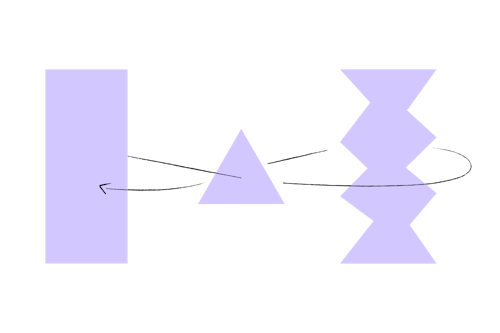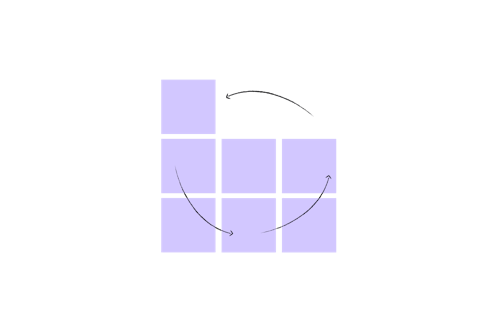How to build app retargeting campaigns during Ramadan
March 29, 2022
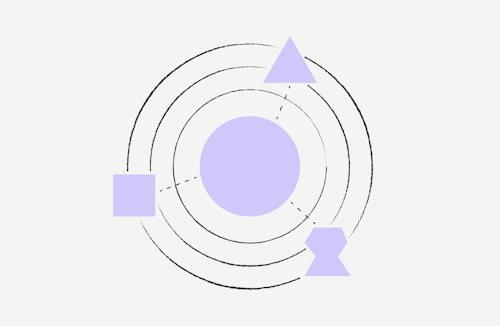
Maria Abdull Latif, Regional Manager, INSEA, at Remerge, held a keynote session at the MMA Global Indonesia event to share her thoughts on app marketing strategies, specifically for in-app retargeting during golden seasonal opportunities like Ramadan.
You can see the entire session video here.
This blog post covers the highlights from Maria’s keynote presentation.
What is seasonality and why is it important for app marketers to consider?
We love to watch the leaves change colors as much as the next person, but when talking about seasonality in marketing, the concept takes on a different, more complex role.
Consumer decisions are directly impacted by seasonality as they often follow specific behavior patterns that are closely tied to the consumer’s way of life, the things they enjoy, and the holidays they celebrate. As a result, seasonal opportunities help mobile app marketers discern the “oh yeah’s” from the “uh-oh’s” in their app growth strategies.
Seasonality matters for app marketers because it directly impacts app growth, in-app traffic and activity, audience engagement, and brand awareness. For example, audiences await specific holidays, expecting special deals, sales, or events. Think of Mother’s Day, where everyone is looking for a florist and deals bloom left and right to help users buy flowers.
Marketing strategies during Ramadan
Many think of Ramadan as a holiday where Muslims fast from sunrise to sunset as part of their faith. While partially true, Ramadan is also an opportunity to gather with family and friends for Iftar and break the fast, join in on Eidul Fitri celebrations, build a sense of empathy with those less fortunate, and embrace the spiritual aspect of the month with mindfulness, reflection, a genuine sense of community, and focus.
From a marketing standpoint, Ramadan is a seasonal opportunity to feast in what’s typically an online shopping galore in the INSEA region. As app marketers, we encourage you to dig deeper into your audience’s local culture, practices, and sentiments as they will play a key role in your marketing strategies.
« Retargeting helps solve the challenges app marketers face when deploying UA campaigns. »
MARIA ABDULL LATIF, REGIONAL MANAGER, INSEA, REMERGE
The importance of brand equity and hyper-local strategies
You can build brand equity during Ramadan with hyper-local strategies. Hyper-local strategies help you communicate your understanding of your consumers and stay relevant with your target audience by using personalized ads.
For example, Indomie, the Indonesian brand of instant noodles launched a Ramadan-based ad campaign a few years ago with two variations of the same ad. One ad didn’t show noodles during the hours when people were fasting, while the other showed noodles during the hours when people broke fast. The brand also used hashtags to empathize with consumers about their effort during Ramadan, making consumers feel understood and more likely to break their fast with Indomie.
App and mobile user behavior during Ramadan
First-party data provides mobile app marketers with a wealth of information about how shifts in daily routines influence mobile interactions.
Let’s see this exemplified by several of our food delivery clients.
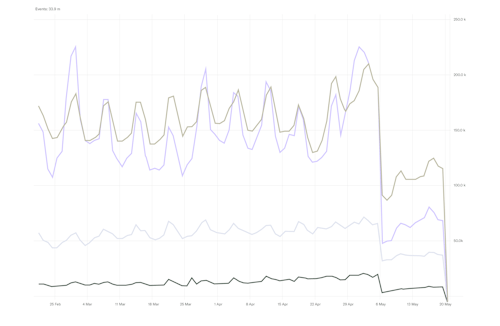
Looking at the above graph of in-app events from 2021, we can see when Ramadan was observed as the overnight dip in in-app activity, whether browsing, adding items to the cart, or completing a purchase, points to when users were fasting.
Let's take a look at shopping apps. We evaluated the activity of unique users inside our client's app, one of the largest shopping apps in the South East Asia region.
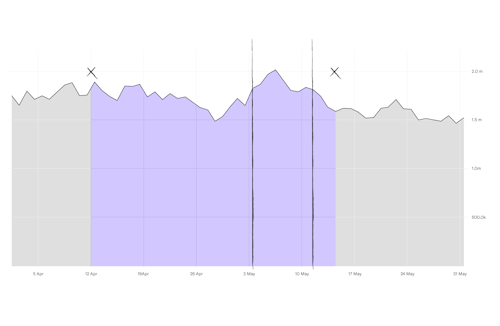
In the graph above, the purple highlight represents Ramadan 2021, where we observed:
- In week one, there was more or less the same number of unique users before Ramadan.
- In week two, there was a declining trend in unique users.
- In week three, there was a peak of up to 200K more unique users than before Ramadan started.
- In week four, there was a steady decline in unique users.
These user insights help build the canvas to work with when it comes to strategizing and executing great campaigns that are relevant and loved by your audience.
Why do in-app performance marketing strategies matter?
For most marketers, tackling app growth, acquiring new users, and getting new installs are the be-all and end-all. However, app growth goes beyond new user acquisition (UA).
Retargeting, which is the heart of what we do at Remerge, is a powerful way for app marketers to improve user lifetime value (LTV) by keeping audiences engaged with highly relevant and personalized mobile app ads.
Retargeting is part of a holistic approach, but unfortunately, some marketers tend to undermine it. Let’s dive into the value of retargeting and how it can be coupled with your UA strategy.
How can retargeting succeed alongside a UA strategy?
User engagement via app verticals
Based on a report by Appsflyer, the uninstall rate between paid installs (users acquired through paid media) versus organic installs is relatively high. Across different verticals, we see an average of about 35% to 40% uninstall rates within 30 days of the install, with gaming and social apps being the highest and food and drink being the lowest.
Every user uninstall is related to the work and investment made when acquiring new users - therefore, it’s vital to think about retention and monetization after installs. Based on the same Appsflyer report, retargeting generates more revenue events in the first 30 days after the install than UA alone. It’s also significantly cheaper to re-engage a user with retargeting strategies versus acquiring new users. And we’re talking 5 to 10 times cheaper, which more than justifies the marketing need to use retargeting app strategies.
Developing a holistic approach
In combination with UA efforts, retargeting helps solve the challenges app marketers face when deploying UA campaigns, including uninstalls, inactive users, or no purchases/no conversions.
- For uninstalls, retargeting helps understand uninstall rates and reduces losses from UA budgets.
- For inactive users, retargeting helps reactivate existing users who stopped engaging with the app.
- For no purchase/no conversion scenarios, retargeting helps drive first or repeat purchases and encourage user loyalty.
At Remerge, by marrying all of these retargeting strategies, we can help you have a full-funnel approach. Let’s see it up close.
- A user downloads your app.
- The user browses your app without completing an in-app purchase.
- The user leaves your app or uninstalls it and opens another app.
- We find the user through the app they are using.
- The user sees your ad with a personalized message.
- The user taps on the ad, is led back to where they left off and completes a specific action. This action can be whatever matches your goals, including re-installing the app, opening the app, completing a registration, or completing a purchase.
« A great ad experience is proven to reactivate lapsed users and drive re-installs with brand recall »
MARIA ABDULL LATIF, REGIONAL MANAGER, INSEA, REMERGE
How can app marketers take advantage of retargeting during Ramadan?
Now that we’ve covered Ramadan sentiments, mobile user behavior, and how to leverage retargeting strategies for a holistic approach in your media buying strategy, here are some tips to bring this all together when creating an ad experience that’s relevant and connects you with your audience in a meaningful way.
Incorporate brand culture into your strategy
Many believe, mistakenly, that performance marketing is for conversions only and not for brand awareness. We often see app marketers undervalue their existing user base and first-party data, even though a great ad experience is proven to reactivate lapsed users and drive re-installs with brand recall.
You should extend your powerful brand into your performance marketing channels to maximize your app efforts.
Engage with conversion in mind and optimize your campaigns
Re-engagement with meaningful brand ads that are personalized helps drive conversions. You can leverage real-time segmentation to enrich ad experiences and serve ads based on user behavior during Ramadan by including:
- Time of day
- Day of the week
- Week of the month
- Location
- Product popularity
- Interest
For example, in a food delivery app, you can
- Add a counter and serve ads after dawn.
- Use a greeting to build a connection with users.
- Suggest hassle-free options to buy a meal two hours before breaking the fast.
- Serve visuals of food to give users an idea of what they might want to have, along with a call to action to order as soon as possible.
- Use the feed to put information about restaurants that are still open before dawn.
In an e-commerce app, you can:
- Give a sneak peek at new arrivals to tempt users into buying items that can help them get ready for Ramadan.
- Based on historical data, look at when people tend to increase their purchasing habits and use that information to deploy promotional ads about a flash sale or slashes in prices.
- Add a sense of urgency in your messaging to convey the time sensitivity of clearance events before the end of Ramadan.
- Set up a counter to help users prepare their houses with all the necessary items for Ramadan.
Develop a creative testing plan
Gathering insights from your Ramadan campaign can improve future campaigns. Remerge supports clients with data analysis, from planning to the actual execution of the marketing campaign.
Testing is vital to understand what elements work and what can be scraped off, and there are several elements you can focus on when developing an innovative testing plan:
- Design elements and copyrights. Test and design different graphic design elements, characters, products, animations, hashtags, taglines, CTAs, etc.
- Ad formats. Static vs. video vs. native.
- Personalization. Create Ramadan-specific promos, offer codes, features, in-app events, etc.
Ultimately, in combination with everything that’s been covered about dynamic segmentation of different user buckets, the goal is to define what you want to measure and learn from your tests.
To sum up
The central message from Maria’s keynote presentation is to maximize your app growth efforts via in-app retargeting to connect with your audience via relevant ads based on hyper-local strategies.
Here’s a roundup of the presentation’s key takeaways:
- Go hyper-local and research consumer sentiments and lifestyles during Ramadan.
- Leverage first-party data to analyze the shift in in-app behavior.
- Increase app engagement with brand creatives.
- Segment and personalize ads to drive conversions.
- Employ creative A/B testing plans to gather insights for your next Ramadan campaign.
Learn about app marketing strategies in latest ID or No? report

